Magnesium deficiency is a serious condition that can have far-reaching implications on one’s health. It can cause symptoms ranging from mild to severe and, in some cases, life-threatening. Knowing the warning signs of magnesium deficiency is critical for maintaining optimal health and avoiding potential complications associated with the condition. This article will explore the signs of magnesium deficiency and how to recognize them early on so you can take action to address them.
The human body requires an adequate level of magnesium for proper function, but many people are unaware of the risk of developing a deficiency. Magnesium plays a significant role in supporting cardiovascular health, regulating blood sugar levels, and aiding in sleep regulation. A lack of this vital mineral can contribute to a wide range of symptoms that affect your well-being and quality of life.
It is necessary to be aware of the signs of magnesium deficiency, as it can occur at any age or lifestyle level. By understanding what to look out for, you can take steps to prevent it from occurring or take action if needed. In this article, we will discuss the warning signs of magnesium deficiency and what you should do if you think that you may have a deficiency.
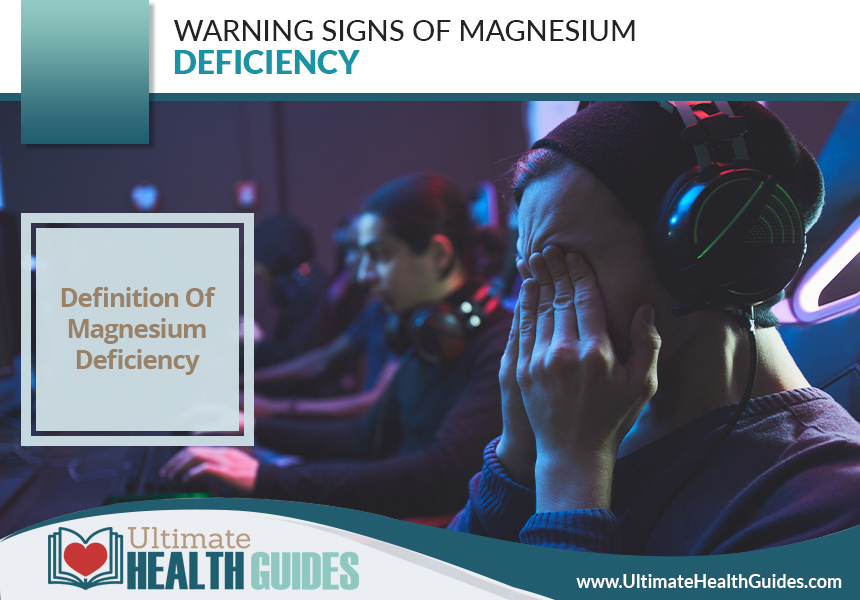
Definition Of Magnesium Deficiency
Magnesium deficiency, also known as hypomagnesemia, is a condition in which the body does not have enough magnesium. It is an electrolyte mineral that helps control various functions of the body, including muscle contraction, nerve transmission, and energy production. Magnesium deficiency can be caused by a variety of factors, such as poor dietary intake, certain medical conditions, or medications. It can also be caused by inadequate absorption of magnesium due to gastrointestinal problems or chronic kidney disease.
Symptoms of magnesium deficiency are often subtle and may include fatigue, lack of appetite, muscle weakness or spasms, irritability, and tremors. In more severe cases, patients may experience confusion, abnormal heart rhythms, and difficulty swallowing. Severe cases can result in seizures or even death if left untreated.
Diagnosis usually involves a physical exam and blood tests to measure the levels of magnesium in the body. Treatment may involve oral supplements to replace lost magnesium levels as well as lifestyle changes, such as increasing dietary sources of magnesium, like green leafy vegetables and nuts. Additionally, other electrolytes, such as calcium and potassium, should be monitored to ensure optimal health and balance among them all.
Magnesium plays a significant role in regulating many bodily processes. Hence, it is essential for overall health. It is vital to maintain a balanced diet that includes plenty of whole grains, legumes, and vegetables, which are good sources of this essential mineral, to prevent magnesium deficiency from occurring.

Symptoms Of Low Magnesium Levels
Low magnesium levels can cause a range of symptoms because this mineral is critical for many bodily processes. It’s crucial to be aware of these signs, as they can indicate a deficiency. Here are four warning signs of magnesium deficiency you should watch out for.
The first symptom to be aware of is muscle cramps or twitches. Low levels of magnesium can interfere with the way nerves and muscles communicate, leading to involuntary contractions or spasms. These may feel like a tight knot in the muscle or an uncomfortable twitch.
The second symptom is fatigue or weakness. Magnesium helps convert food into energy and is involved in many metabolic processes, so when it’s lacking, your energy levels may drop significantly. This can lead to feeling physically drained and unable to perform at your usual level of activity.
If you start having difficulty sleeping, that could be another sign of magnesium deficiency. Magnesium helps regulate the body’s sleep-wake cycle and plays a significant role in relaxation and stress reduction. If your body isn’t getting enough magnesium, it may not be able to produce melatonin, the hormone responsible for helping us fall asleep and stay asleep throughout the night.
Finally, anxiety and irritability are also potential warning signs of low magnesium levels in the body. Magnesium helps regulate neurotransmitter function and is thought to inhibit overactivity in certain parts of the brain that control emotions and moods, such as fear or worry. When there’s not enough magnesium present, these areas become more active, resulting in increased feelings of anxiousness or agitation.
These are just some of the warning signs associated with low magnesium levels; other possible symptoms include headaches, irregular heartbeats, loss of appetite, nausea, vomiting, confusion, and more. If you experience any combination of these symptoms regularly, it’s vital to look into being tested for a possible deficiency so that appropriate treatment can be provided if necessary. From here, we’ll explore factors that contribute to magnesium deficiency so we can better understand how this nutrient imbalance develops in our bodies.

Factors That Contribute To Magnesium Deficiency
Do we understand the causes of magnesium deficiency? This is a critical question to ask, as magnesium is essential for many processes in the body, and its deficiency can lead to a host of health issues. Here are some of the factors that contribute to low magnesium levels.
One potential cause of magnesium deficiency is poor dietary intake. Many people don’t get enough of the mineral from their diet either due to a lack of variety or nutrient-poor food choices. Eating a balanced diet with plenty of plant-based foods, such as legumes, greens, nuts, and seeds, is one way to improve your intake. Additionally, some medications may inhibit the absorption of magnesium from food sources.
Reduced absorption from the gastrointestinal tract is another possible cause. Certain conditions like irritable bowel syndrome or Crohn’s disease can impair the absorption of minerals like magnesium. Other conditions, such as diabetes and celiac disease, can also be associated with reduced levels due to impaired absorption in the gut.
Excessive alcohol consumption has been linked with lower levels of magnesium due to increased excretion through urine and sweat. Excessive sweating during exercise can also lead to reduced levels. This is because more minerals are lost through perspiration than normal during physical activity.
Finally, certain medications, such as diuretics and antibiotics, can interfere with magnesium absorption or increase excretion leading to deficiencies over time. It’s vital for people taking these medications regularly to monitor their levels closely or consider supplementing if needed in order to maintain healthy levels. With this knowledge about contributing factors in mind, let us now turn our attention toward understanding what causes low magnesium levels in detail.

Causes Of Low Magnesium Levels
Magnesium deficiency can be caused by a variety of different factors. A few of the causes are diet, medication use, and medical conditions. These are the most common.
First, diet is one of the primary contributors to magnesium deficiency. People who regularly eat processed foods and fast food often lack proper nutrition, including magnesium-rich foods, like dark green leafy vegetables and whole grains. In addition, people who consume alcohol or caffeine frequently can be more prone to magnesium deficiencies due to reduced absorption rates in the body.
Second, certain medications can also interfere with the body’s ability to absorb magnesium. Commonly prescribed drugs, such as proton-pump inhibitors (PPIs), diuretics, statins, and antibiotics, can all significantly reduce levels of magnesium in the body. Additionally, individuals taking calcium supplements without adequate amounts of magnesium may also be at risk of developing a deficiency.
Finally, health conditions such as diabetes, kidney disease, celiac disease, Crohn’s Disease, lactose intolerance, and gastrointestinal surgeries can all affect how much magnesium a person absorbs from their food and supplements. These conditions impair the ability of the intestines to absorb nutritional minerals properly, leading to low levels of magnesium in the body. Understanding what puts someone at risk of developing a magnesium deficiency is crucial for maintaining optimal health and well-being. Who is at risk?

People At Risk Of Magnesium Deficiency
A chill runs down the spine of anyone who may be at risk for magnesium deficiency, and it’s more people than you might think. It can affect any age group, gender, or race. Many health conditions can put someone at risk, including gastrointestinal disorders, such as Crohn’s disease and ulcerative colitis. Those with Type 2 diabetes are also at an increased risk due to the body having difficulty absorbing nutrients from the small intestine. Kidney disease is another factor that can increase the potential for magnesium deficiency because of how it affects the kidneys’ ability to filter out magnesium in the urine.
Other lifestyle factors can contribute to a lack of magnesium in the body as well. For example, those who consume large amounts of alcohol every day or regularly take certain medications, like diuretics or antibiotics, may find their magnesium levels depleted. In addition, if a person has an eating disorder, such as anorexia nervosa or bulimia, they could be at risk due to an inadequate intake of essential vitamins and minerals.
The elderly population is particularly vulnerable due to changes in their metabolism and dietary habits that occur with age. Lastly, athletes who engage in strenuous physical activity on a regular basis may also be more likely to develop a deficiency. This is due to their increased need for electrolytes and minerals.
Therefore, while anyone can develop a magnesium deficiency, some people have higher risks than others, which should not be taken lightly. Knowing what the warning signs are is key to catching it early before it becomes more serious. Transitioning into how monitoring magnesium levels is critical for maintaining good health.

How To Monitor Magnesium Levels
Monitoring magnesium levels is a crucial step to ensure that a person’s health is not being impacted by a deficiency. There are several ways to check for a magnesium deficiency, including through the use of blood tests and urine tests. Here are a few tips for monitoring your magnesium levels.
- Consider lifestyle changes. Making changes to diet and exercise can help increase the body’s magnesium levels. Eating more green leafy vegetables, nuts, legumes, and whole grains can provide the body with valuable nutrients that can help maintain healthy levels of magnesium.
- Take supplements. Magnesium supplements can be taken to ensure that a person has enough of this mineral in their system. It is best to look for supplements that have been tested and approved by healthcare professionals. Taking too much of this supplement can cause serious side effects, so it’s crucial to speak with a healthcare provider before taking any kind of supplement.
- Have regular checkups with your doctor. Regularly seeing a healthcare professional will allow them to monitor your health and make sure that you do not have any underlying health issues that could be contributing to low magnesium levels. This is especially crucial if you are experiencing any signs or symptoms of magnesium deficiency.
By making these adjustments, you can make sure that your body is getting enough of this essential mineral and prevent any potential complications from developing due to low levels of magnesium in the body. With proper monitoring and lifestyle changes, it’s possible for most people who suffer from low levels of magnesium to return their bodies to balance. Moving forward, it’s crucial to understand how diagnosis and testing for low magnesium levels work in order to effectively treat the condition.

Diagnosis And Testing For Low Magnesium Levels
It’s like a hidden secret that few know of and even fewer understand. Magnesium deficiency is a silent killer, with symptoms that are often masked or ignored by the body’s other needs. Diagnosing and testing for low magnesium levels is the first step to ensuring that you get the vital nutrients your body needs.
A medical doctor can diagnose magnesium deficiency through physical exams and laboratory tests. Examination of muscle reflexes, heart rate, breathing patterns, and other physical responses can help determine if there are any signs of deficiency. If needed, blood tests can be ordered to measure serum magnesium levels in the blood. They may also order an imaging test, such as an X-ray or MRI, to check for any signs of damage caused by the deficiency.
Urine tests are often used to detect magnesium levels in the body. These tests can measure both total and free amounts of magnesium present in urine samples. Healthcare providers may also use hair analysis or skin biopsies to further evaluate potential sources of deficiencies in magnesium levels.
The best way to ensure healthy magnesium intake is to follow a balanced diet that’s rich in whole grains, legumes, green leafy vegetables, nuts and seeds, dark chocolate, and avocados. These are all foods high in magnesium content. With proper diagnosis and testing for low magnesium levels combined with a healthy diet, individuals can ensure that they stay adequately supplied with this essential mineral for optimal health and well-being going forward.
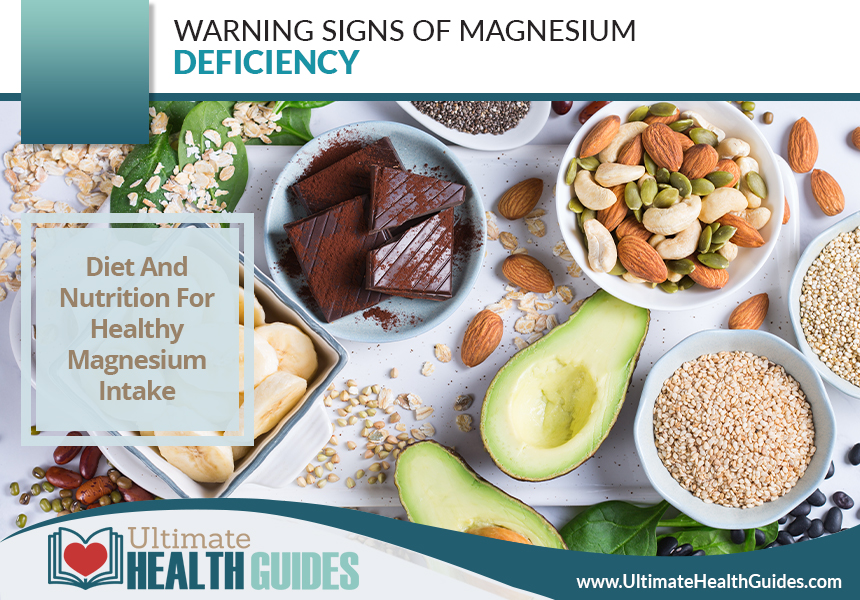
Diet And Nutrition For Healthy Magnesium Intake
Good nutrition is paramount for healthy magnesium levels. Eating a balanced diet with plenty of fruits, vegetables, and whole grains can help ensure adequate magnesium intake. However, certain health conditions and medications may interfere with the body’s absorption of magnesium from food sources. Here are some common warning signs that you may be deficient in magnesium.
- Fatigue
- Loss Of Appetite
- Übelkeit
- Vomiting
- Muscle Cramps Or Spasms
- Weakness
- Irregular Heartbeat
Determine if dietary changes are necessary to increase your magnesium intake. You can do this by keeping track of your current dietary habits. The following table outlines foods that are high in magnesium.
| Food | magnesium (mg) per 100 g |
|—————|————————-|
| Spinach | 79 |
| Almonds | 270 |
| Dark Chocolate| 327 |
| Cashews | 292 |
| Sunflower Seeds| 328 |
Eating a variety of these foods can help you meet your recommended daily allowance (RDA) for magnesium intake. Additionally, drinking water that is high in minerals, such as spring water, can also help increase your body’s total magnesium content. If symptoms persist despite dietary changes, it may be time to look into other methods of increasing your magnesium. Supplements are available to provide extra support when needed.

Supplements To Increase Magnesium Intake
It’s a widely accepted theory that taking dietary supplements is the best way to increase magnesium intake. But is it really? To answer this question, let’s examine the evidence.
Research has shown that taking magnesium supplements, such as magnesium oxide, can be helpful in raising blood magnesium levels. However, they may not be as effective as food sources of magnesium. The body absorbs most minerals more efficiently when they come from food sources than from supplements.
In addition to supplementation, certain lifestyle changes can also help boost magnesium intake. Getting regular exercise and adequate sleep helps your body absorb and use minerals more efficiently. Stress reduction techniques have also been found to improve nutrient absorption by your body and reduce inflammation that can interfere with mineral uptake.
Are you looking for ways to increase your magnesium levels? If you are, consider focusing on improving your diet and lifestyle first before reaching for a supplement bottle. Eating foods high in magnesium, like legumes, nuts, and seeds, can go a long way toward helping you meet your daily requirements.

Foods High In Magnesium
Magnesium is an essential mineral for the body to function properly. It’s involved in over 300 biochemical reactions and is necessary for muscle, nerve, and immune system health. As such, it’s crucial to make sure that you’re getting enough magnesium through your diet or supplements. Eating foods that are high in magnesium can help ensure that your body has adequate levels of this important nutrient. There are many food sources of magnesium, including leafy green vegetables, legumes, nuts and seeds, whole grains, yogurt, milk, and fish.
Leafy greens, like spinach and kale, are particularly rich in magnesium; legumes, such as black beans, kidney beans, and chickpeas, also contain high levels of the mineral. Nuts, like almonds and cashews, boast impressive amounts of magnesium, along with vitamin E and other healthy fats. Whole grains, like brown rice, oats, barley, and quinoa, are excellent sources of magnesium as well as fiber and protein. Yogurt contains both calcium and magnesium, while milk provides a good dose of these two minerals, along with protein. Lastly, fish, such as salmon or halibut, provide not only ample amounts of magnesium but also heart-healthy omega-3 fatty acids.
In addition to natural food sources of magnesium, there are fortified foods available. These may be beneficial for those on restrictive diets or who don’t regularly consume the foods listed above. Fortified cereals may contain added vitamins and minerals, such as zinc or iron, as well as some brands adding in plant-based proteins for extra nutritional value.
When trying to increase your intake of magnesium from food sources, it’s critical to remember not to overdo it by consuming too much at once since this could lead to unpleasant side effects, such as nausea or diarrhea, due to its laxative effect on the body when taken in excessive amounts. Therefore it’s recommended that individuals looking to increase their dietary intake should spread out their consumption over multiple meals throughout the day rather than trying to get all their daily needs at once. By eating a variety of foods that are high in magnesium, you can help ensure that you’re getting enough of this critical mineral each day, which can have a positive impact on overall health and well-being. With proper planning ahead by stocking up on these nutritious items, you can easily create delicious meals filled with energy-boosting nutrients like magnesium!
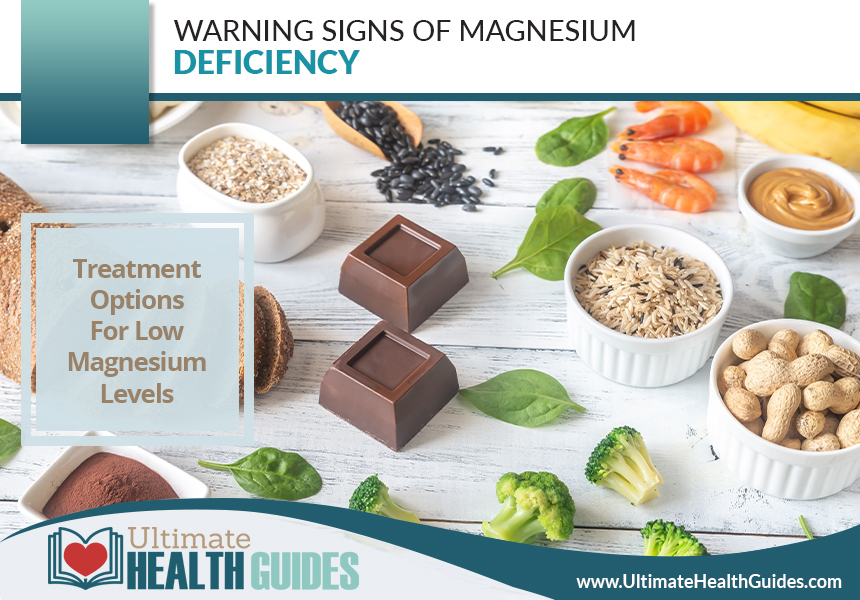
Treatment Options For Low Magnesium Levels
John is a 45-year-old man who was diagnosed with a magnesium deficiency during his yearly physical. He was told that he would need to start supplementing his diet with magnesium and that he could also make some lifestyle changes. But what are the treatment options for those with low magnesium levels?
The most common form of treatment for those with low magnesium levels is supplementation. This may include taking oral supplements, such as tablets or capsules, or intravenous (IV) infusions. Speaking with a trusted professional to find out which type of supplement is best suited for you based on your individual needs is advised. In addition to supplementation, dietary changes may be necessary to ensure an adequate intake of magnesium from food sources. Foods high in magnesium include green leafy vegetables, nuts, seeds, and legumes.
Another option for treating low magnesium levels is a course of chelation therapy. Chelation therapy involves administering chelating agents (chemicals that bind or trap metals) intravenously over a period of time to remove minerals and heavy metals from the body. It has been found to be effective in increasing serum magnesium levels in some studies; however, more research is needed to determine its efficacy in treating long-term deficiencies.
Finally, alternative therapies, such as acupuncture and massage, have been used by some practitioners to increase the body’s absorption of nutrients, including magnesium. There is limited scientific evidence backing up these therapies. However, anecdotal reports suggest that they may be helpful in increasing overall health and well-being when combined with other treatments, like supplementation and dietary changes.
In light of this information on available treatments for low magnesium levels, it’s clear that there are a number of approaches one can take to ensure that their body has adequate amounts of this essential mineral. Each has various benefits depending on individual needs and preferences. Exploring alternative therapies for increasing magnesium intake can help individuals find the solution that works best for them.
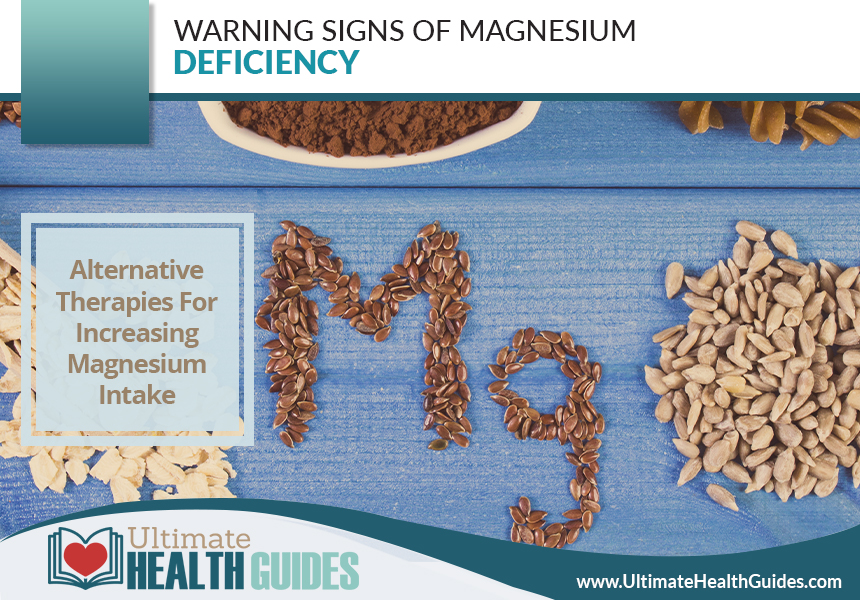
Alternative Therapies For Increasing Magnesium Intake
There are many advances in medical treatments for low magnesium levels. However, some may prefer alternative therapies to increase their intake. These can include lifestyle changes, dietary modifications, and supplementation.
Lifestyle changes (such as reducing stress and increasing physical activity) can help increase the body’s ability to absorb nutrients. Reducing alcohol consumption and avoiding processed foods are also beneficial. Additionally, exposure to sunlight helps the body convert vitamin D into a form that aids in magnesium absorption.
Dietary modifications are another way to boost magnesium levels. Magnesium-rich foods, such as leafy greens, nuts, seeds, legumes, whole grains, and fish, should be included in the diet. Eating smaller meals more frequently throughout the day rather than three large meals is also recommended, as this can provide better absorption of nutrients from foods.
A supplement is an option for those who need additional support or cannot get enough from dietary sources alone. Magnesium supplements come in various forms, such as tablets, capsules, powders, or liquids, which can be taken orally or applied topically, depending on individual needs. It is critical to speak with a healthcare professional before taking any type of supplement to ensure safety and that the appropriate dosage instructions are followed.
When making lifestyle changes or taking supplements to increase magnesium intake, it is necessary to monitor how the body responds. It is also vital to consult with a healthcare provider if there are any concerns or questions about treatment options. With careful consideration and monitoring of treatments for low magnesium levels, it is possible to find an approach that works best for each individual situation.

Complications Of Low Magnesium Levels
When magnesium levels fall below the body’s requirements, it can lead to a number of possible complications. These include muscle cramps and spasms, which can be painful and interfere with daily activities. Low magnesium levels can also cause irregular heart rhythms, known as arrhythmias. These can increase your risk of stroke or heart attack if left untreated. In addition, low magnesium levels can result in depression and anxiety as well as cognitive issues like difficulty concentrating or confusion.
Low magnesium levels in the blood, known as hypomagnesemia, have been linked to an increased risk of diabetes and metabolic syndrome. This is likely because magnesium helps regulate insulin sensitivity and glucose metabolism in the body. Furthermore, people with low magnesium may have reduced calcium absorption, leading to weakened bones and a higher risk of osteoporosis.
Additionally, low magnesium may contribute to high blood pressure. It does this by causing constriction of the arteries and veins, leading to high resistance against blood flow. This increases the workload on the heart, making it work harder than usual and raising blood pressure readings.
Low levels of this essential mineral can also cause fatigue, headaches, and migraines. Magnesium helps produce ATP (cellular energy), so insufficient amounts mean that cells cannot function optimally, resulting in a feeling of exhaustion even after restful sleep or short periods of activity. It’s necessary to recognize these symptoms early on in order to mitigate further damage that could occur from prolonged deficiency states. Transitioning into prevention strategies is key to avoiding these complications related to inadequate magnesium intake.
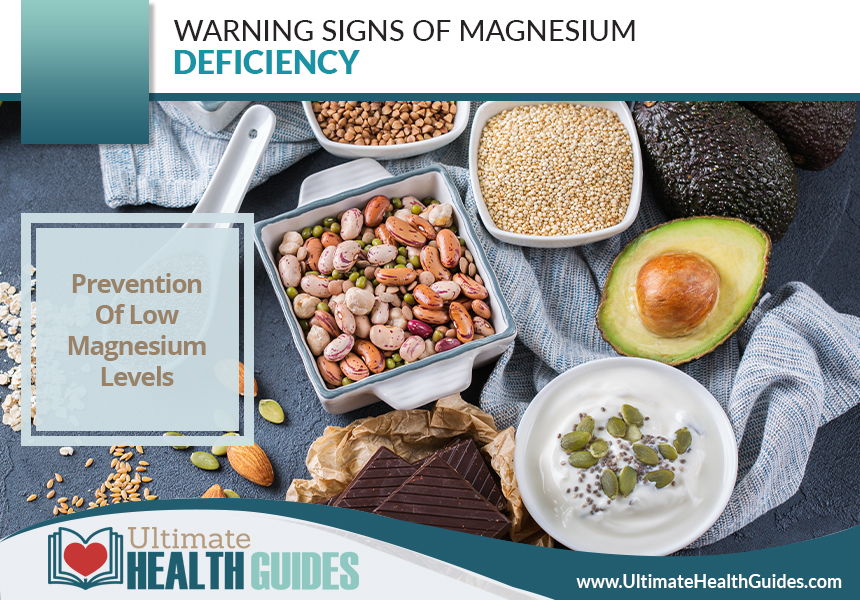
Prevention Of Low Magnesium Levels
The key to the prevention of low magnesium levels is to be aware of its warning signs. It is necessary to recognize the symptoms of deficiency and take steps to ensure that magnesium levels remain within a healthy range. Fortunately, there are a few simple ways to do this.
First, it is paramount to ensure that you are getting enough dietary magnesium. Eating foods such as nuts, beans, spinach, and whole grains can help increase your intake of this mineral. Additionally, taking a daily supplement may help prevent magnesium deficiency. It is paramount that you talk to your healthcare provider before starting any new supplements or making significant changes to your diet.
Second, it is crucial to maintain an active lifestyle and manage stress levels in order to keep magnesium levels balanced. Regular exercise helps reduce stress and promotes good health overall. Additionally, relaxation techniques, such as yoga and meditation, can be beneficial in reducing anxiety and maintaining overall balance in life.
Finally, it is worthwhile for individuals at risk of low magnesium levels to have their levels checked regularly by a healthcare provider. It is critical for those with chronic diseases or who take certain medications to do so. This will enable them to make sure that their levels remain within the optimal range and receive treatment if necessary.
Individuals should follow these guidelines for the prevention of low magnesium levels. By doing so, they can ensure that they stay healthy and enjoy an improved quality of life long-term. With proper awareness and management of this mineral’s warning signs, people can live life without the fear of being held back by deficiencies or complications related to them.

The Long-Term Outlook
When it comes to magnesium deficiency, the long-term outlook can vary greatly. Without proper care and treatment, many of the warning signs can persist or become worse. Here are four potential outcomes.
- Severe fatigue and exhaustion due to low energy levels
- Muscle cramps and spasms that can cause pain and discomfort
- A weakened immune system, leading to frequent infections
- Increased risk of osteoporosis, heart disease, and stroke
These are just a few of the issues that can arise from a lack of magnesium in the body. It is vital for individuals to receive medical advice about their condition so they can properly monitor their symptoms and receive appropriate treatment. Taking magnesium supplements may help alleviate some symptoms, but it’s best to consult with a healthcare professional before starting any supplement regimen. Additionally, eating foods rich in magnesium, such as leafy greens, nuts, seeds, legumes, avocados, bananas, and whole grains, can also be beneficial.
It is possible for some people with magnesium deficiency to make significant improvements with dietary modifications or supplementation. However, if left untreated or inadequately treated, long-term consequences, such as hypertension (high blood pressure), electrolyte imbalance, anemia (low red blood cell count), cognitive impairments, or even death, could occur. Therefore, it is paramount to get regular checkups and follow any recommendations given by your physician.
In order to stay healthy and reduce the risk of serious health complications due to magnesium deficiency, awareness is key. Identifying early warning signs, such as fatigue or muscle aches, will allow you to take action sooner rather than later in order to improve your overall health outcomes. Taking steps, like eating nutritious meals regularly and consulting with your healthcare provider about any concerns you may have, will help ensure that you maintain optimal health for years to come.

Häufig gestellte Fragen
How Much Magnesium Should I Take Daily?
Magnesium is an essential mineral that plays a significant role in human health, and many people are not getting enough of it. Knowing how much magnesium to take daily can be tricky, as there are many factors to consider. Here are the most important things you need to know about magnesium supplementation, including recommended daily allowances (RDAs) and possible side effects.
The RDA for magnesium depends on age and gender. Generally speaking, adult men should aim for 400-420 milligrams (mg) each day, while adult women should try to get 310-320 mg. To ensure that you’re getting the right amount, you should learn how much magnesium you require to fill your personal needs. If you’re considering taking a supplement, it’s vital to read labels carefully to make sure that you’re not exceeding the recommended dosage.
While magnesium supplements can provide a number of benefits, they can also cause potential side effects if taken in excessive amounts. Symptoms may include diarrhea, nausea, appetite loss, and abdominal cramps. It’s also crucial to note that some medications can interact negatively with magnesium supplements, so it’s always wise to discuss any supplements with your physician before beginning them.
When it comes to assessing your risk of deficiency and deciding how much magnesium you should take daily, the best thing to do is talk with your healthcare provider or nutritionist, who will be able to make an informed decision based on your individual needs and lifestyle factors, such as diet and activity level. They will also be able to monitor for any potential side effects or drug interactions associated with taking a supplement or changing your diet. With the right information in hand, you can make an informed decision about whether or not adding magnesium to your routine is right for you.
Can Magnesium Deficiency Be Reversed?
Magnesium is a mineral found in your body, playing a significant role in many bodily functions. It’s possible for people to be deficient in magnesium, so it’s paramount to know the warning signs and what can be done if someone is deficient. But can magnesium deficiency be reversed?
The short answer is yes; magnesium deficiency can be reversed with proper supplementation and dietary modifications. However, it should be noted that reversing a deficiency may take some time. That being said, there are steps that one can take to help ensure that their levels of magnesium are corrected and maintained.
For starters, increasing your intake of foods high in magnesium can be beneficial for those looking to correct a deficiency. Foods such as spinach, almonds, cashews, black beans, avocados, and bananas are all good sources of magnesium. Additionally, adding supplements, like magnesium citrate or glycinate, may help increase levels more quickly than relying solely on dietary changes alone.
It’s also worth noting that if someone is experiencing symptoms of deficiency, they should speak to their healthcare provider first. Magnesium levels might need to be tested before starting any supplementation or dietary modification plan. And while it’s possible for individuals to reverse their own deficiencies without medical assistance or intervention, consulting a trusted healthcare provider first can help ensure the safety of the individual and provide them with a solid plan for correcting their deficiency long-term.
Making sure that you have enough magnesium in your body is paramount for overall health and well-being. Take steps toward correcting a deficiency through diet or supplementation. It could make all the difference when it comes to feeling your best every day.
Are There Any Over-The-Counter Treatments For Low Magnesium Levels?
Low magnesium levels can cause a variety of health problems. So it’s crucial to take steps to ensure that your magnesium intake is sufficient. But if you’ve already developed symptoms of magnesium deficiency, are there any over-the-counter treatments available?
When it comes to treating low magnesium levels, the best approach is prevention. Eating a balanced diet rich in fresh fruits and vegetables can help maintain healthy levels of magnesium in the body. Taking a supplement containing both calcium and magnesium may also be beneficial. However, if you do experience signs of deficiency, such as fatigue or muscle cramps, there are some over-the-counter treatments available.
Magnesium salts, including Epsom salt and other forms of magnesium sulfate, can be taken orally as supplements or added to baths where they are absorbed through the skin. Another popular option is oral citrate supplements that may help improve energy levels and reduce muscle pain associated with low magnesium levels. Magnesium oil sprays are also available, which can be applied directly to the skin for faster absorption and relief from symptoms. Some studies have even suggested that eating dark chocolate or taking probiotics may help increase your body’s absorption of dietary magnesium.
It’s important to do some research before taking any over-the-counter treatments for low magnesium levels, as they can interact with certain medications or medical conditions. As always, prevention is better than cure. So make sure that you’re getting enough dietary sources of magnesium in order to avoid potential deficiencies in the future!
Are There Any Side Effects Associated With Taking Magnesium Supplements?
Taking magnesium supplements can be a great way to increase your magnesium levels, but it is important to be aware of potential side effects. Many people take magnesium supplements without any issues, but it is still important to know what you might experience before taking them. Here are four common side effects associated with taking magnesium supplements.
- Diarrhöe
- Nausea And Vomiting
- Abdominal Cramping
- Low Blood Pressure
Large-dose magnesium supplement users frequently experience diarrhea, nausea, and vomiting as their bodies adjust to the abrupt change in mineral intake. Moreover, some individuals may develop abdominal cramps, which, if addressed, can be irritating as well as severe. Also, taking magnesium supplements carries the risk of developing low blood pressure, so it’s critical to keep an eye on your vital signs and pay attention if you feel faint or dizzy after taking them.
Magnesium supplements may also conflict with other drugs that you may be taking. So it’s vital to let your doctor know about all the vitamins and minerals you frequently take. Also, it’s critical that you talk to your doctor about any underlying health issues that may be influenced by taking extra minerals, especially anything that is connected to renal function, because they could worsen if not carefully monitored.
Before deciding whether or not to take a magnesium supplement or any other mineral or vitamin, you should thoroughly examine the potential hazards and advantages associated with doing so. If you have any underlying health issues that could make taking particular dietary supplements harmful to your present health, discussing them with your doctor will help you find out. With the proper knowledge, taking magnesium supplements can be a powerful approach to restoring your levels while avoiding any negative side effects.
Are There Any Foods You Should Avoid If You Have Low Magnesium Levels?
If you have low magnesium levels, it’s important to monitor your diet. There are some foods that can interfere with how much magnesium your body absorbs. These should be avoided if possible.
First, let’s look at the foods that contain particularly high levels of oxalates. Oxalates are organic compounds found in some vegetables and grains that bind to calcium and magnesium molecules and reduce their absorption rate in the body. These include spinach, rhubarb, Swiss chard, beets, nuts, chocolate, and wheat bran.
Second, many processed and refined foods are also high in sodium or phosphorus. These two substances compete with magnesium for absorption. These include foods like white bread, pasta, crackers, and other refined starches and processed meats, like hot dogs or frozen dinners.
Thirdly, certain types of beverages can lead to further depletion of magnesium levels due to their diuretic effect on the body. This includes caffeinated drinks, such as coffee, tea, and alcohol. They can cause increased urination, which can cause electrolyte imbalances, including a lack of magnesium over time.
Finally, it’s important to note that dietary changes alone may not be enough to restore adequate levels of magnesium in the body. Supplementation may also be necessary for some individuals. Here is a list of four tips for increasing one’s daily intake.
- Increase consumption of dark leafy greens, like kale or collards.
- Eat more legumes, such as chickpeas or lentils.
- Incorporate whole grains, like quinoa or brown rice, into meals.
- Get more seafood, like salmon or mackerel, into your diet.
For those who don’t feel comfortable taking supplements or cannot increase their dietary intake enough to reach optimal levels of magnesium, there are other options available, such as transdermal patches or topical creams. These can help replenish lost stores quickly and safely. Ultimately it’s important to speak with your healthcare provider about what option might work best for you given your particular situation and lifestyle needs.

Schlussfolgerung
It’s important to understand the warning signs of magnesium deficiency and to know how much magnesium you should be taking daily. Magnesium deficiency is something that can be reversed with dietary changes, supplements, and other treatments. However, it’s important to note that there can be side effects associated with taking magnesium supplements, so it is best to talk to your doctor, do your research, and examine your options before beginning any treatment plan.
In addition, certain foods may make the symptoms of low magnesium worse. If you are concerned about your levels of magnesium, try avoiding processed foods. Eat more fresh fruits and vegetables in order to increase your intake naturally.
<
p align=”justify”>Ultimately, getting enough magnesium is paramount for optimal health. It’s like a superhero for your body! With the right diet and supplementation plan in place, you’ll soon be feeling supercharged and ready to tackle anything life throws your way.














